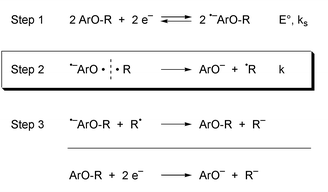Thermodynamics and kinetics of homolytic cleavage of carbon–oxygen bonds in radical anions obtained by electrochemical reduction of alkyl aryl ethers
Abstract
The properties and the reactivity of the

* Corresponding authors
a Laboratoire d'Electrochimie Moléculaire, Université Paris 7 Denis Diderot 2, place Jussieu, 75251 Paris Cedex 05, France
b
Departament de Química, Universitat Autònoma de Barcelona, Barcelona, E-08193 Bellaterra, Spain
E-mail:
lluminada.Gallardo@uab.es
Fax: + 34 93-581-2920
The properties and the reactivity of the

 Please wait while we load your content...
Something went wrong. Try again?
Please wait while we load your content...
Something went wrong. Try again?
C. P. Andrieux, M. Farriol, I. Gallardo and J. Marquet, J. Chem. Soc., Perkin Trans. 2, 2002, 985 DOI: 10.1039/B110994D
To request permission to reproduce material from this article, please go to the Copyright Clearance Center request page.
If you are an author contributing to an RSC publication, you do not need to request permission provided correct acknowledgement is given.
If you are the author of this article, you do not need to request permission to reproduce figures and diagrams provided correct acknowledgement is given. If you want to reproduce the whole article in a third-party publication (excluding your thesis/dissertation for which permission is not required) please go to the Copyright Clearance Center request page.
Read more about how to correctly acknowledge RSC content.
 Fetching data from CrossRef.
Fetching data from CrossRef.
This may take some time to load.
Loading related content
